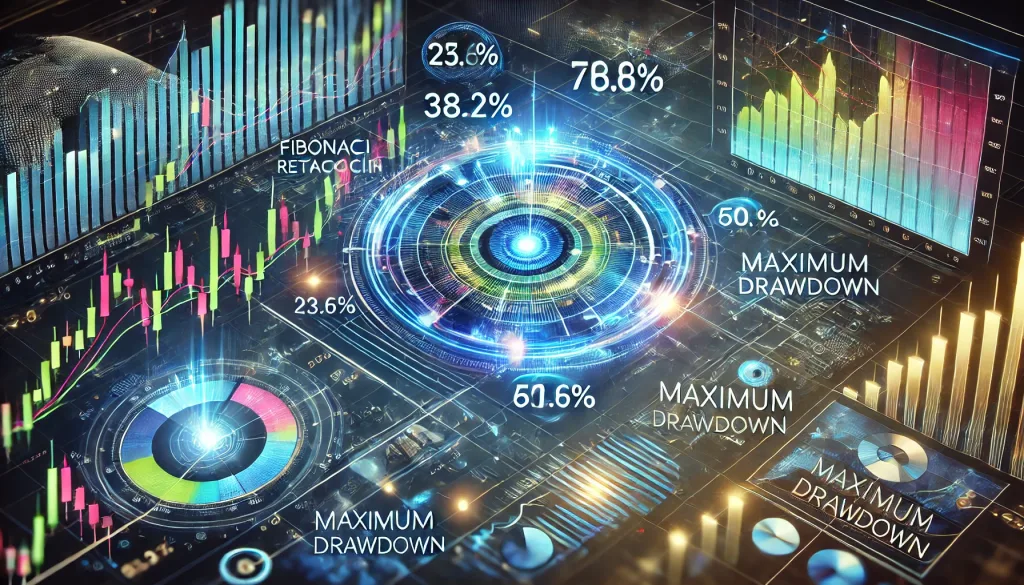Master Fibonacci Retracement and Maximum Drawdown Like a Pro

Imagine this: You’re at a buffet, stacking your plate with all the good stuff, but you know the pain of overindulging is just around the corner. That’s exactly how a Forex trader feels when they don’t balance risk and reward using Fibonacci retracement and maximum drawdown. But fear not—this article is your golden plate of strategy, helping you navigate these powerful tools to minimize risk and maximize reward.
The Fibonacci Secret Sauce: Not Just for Mathematicians
Fibonacci retracement levels may sound fancy, but think of them as your GPS for price movement. These levels are like speed bumps in the market, where price tends to pause, reverse, or gather steam.
How It Works:
- Identify a significant high and low in your chosen currency pair.
- Apply the Fibonacci retracement tool (most trading platforms offer it).
- Focus on the magic levels: 23.6%, 38.2%, 50%, 61.8%, and 78.6%.
Pro Tip:
Ever feel like the market is playing mind games? The 61.8% level, known as the golden ratio, is where price loves to boomerang back before resuming its trend. If this level had a fan club, it’d be full of seasoned traders.
Humorous Anecdote:
Trading without Fibonacci retracement is like trying to catch a bus without knowing the schedule—you’re either too early, too late, or flat-out lost.
Maximum Drawdown: Keeping the Monster Under the Bed
Drawdown is the difference between your account’s high watermark and its lowest dip. It’s the monster that traders fear but rarely acknowledge until it’s gnawing at their equity.
Why It Matters:
- It’s a reality check. If your maximum drawdown hits 50%, you’d need a 100% gain just to break even. Ouch!
- It keeps your risk appetite in check, ensuring you don’t blow up your account in a single impulsive trade.
Pro Tip:
Set a personal maximum drawdown threshold. For example, if your strategy allows for a 15% drawdown, stick to it religiously. It’s your financial lifeline.
Humorous Comparison:
Ignoring drawdown is like ignoring a leaky faucet. At first, it’s just a drip, but soon you’ll be knee-deep in water (or losses).
The Ninja Combo: Fibonacci Meets Drawdown
Here’s where the magic happens. Use Fibonacci retracement to identify potential entry points and pair it with drawdown management to protect your equity.
Step-by-Step Guide:
- Analyze the Trend: Identify if the market is bullish or bearish.
- Mark Key Levels: Use Fibonacci retracement to highlight potential reversal zones.
- Set Risk Parameters: Calculate your risk per trade (e.g., 2% of your account).
- Monitor Drawdown: If your drawdown exceeds your set limit, reduce trade sizes or take a breather.
Case Study:
Last year, a trader used this combo on EUR/USD. By entering trades near the 50% retracement level and limiting drawdown to 10%, they achieved a 25% annual return.
Bust These Myths About Fibonacci and Drawdown
Myth 1: Fibonacci Retracement Works Only in Trending Markets
Reality: It’s effective even in range-bound markets when combined with other indicators.
Myth 2: Maximum Drawdown Is Just a Number
Reality: It’s your psychological safety net. A lower drawdown means less stress and better decision-making.
Humorous Analogy:
Believing these myths is like thinking chocolate cake is calorie-free if you eat it standing up. Spoiler: It’s not.
Hidden Opportunities: Beyond the Basics
Emerging Trend: AI-Powered Fibonacci Tools
Automated trading platforms now use AI to identify Fibonacci levels and manage drawdown in real time.
Underground Tactic:
Combine Fibonacci retracement with harmonic patterns (like the Gartley or Bat). This duo is like pairing wine with cheese—a match made in heaven.
From Theory to Action
Mastering Fibonacci retracement and managing maximum drawdown isn’t just about avoiding losses; it’s about building a sustainable trading strategy. Remember:
- Use Fibonacci levels as your roadmap.
- Treat drawdown like a guardrail.
- Combine both for a foolproof plan.
And if you ever feel overwhelmed, just remember: Trading is like cooking. Start with the basics, experiment, and soon, you’ll be serving up profitable trades like a Michelin-star chef.
Key Takeaways:
- Fibonacci Levels: Use them to identify entry and exit points.
- Maximum Drawdown: Set a threshold to protect your capital.
- Combo Strategy: Blend these tools for optimal results.
—————–
Image Credits: Cover image at the top is AI-generated
PLEASE NOTE: This is not trading advice. It is educational content. Markets are influenced by numerous factors, and their reactions can vary each time.

Anne Durrell & Mo
About the Author
Anne Durrell (aka Anne Abouzeid), a former teacher, has a unique talent for transforming complex Forex concepts into something easy, accessible, and even fun. With a blend of humor and in-depth market insight, Anne makes learning about Forex both enlightening and entertaining. She began her trading journey alongside her husband, Mohamed Abouzeid, and they have now been trading full-time for over 12 years.
Anne loves writing and sharing her expertise. For those new to trading, she provides a variety of free forex courses on StarseedFX. If you enjoy the content and want to support her work, consider joining The StarseedFX Community, where you will get daily market insights and trading alerts.
Share This Articles
Recent Articles
The GBP/NZD Magic Trick: How Genetic Algorithms Can Transform Your Forex Strategy
The British Pound-New Zealand Dollar: Genetic Algorithms and the Hidden Forces Shaping Currency Pairs
Chande Momentum Oscillator Hack for AUD/JPY
The Forgotten Momentum Trick That’s Quietly Dominating AUD/JPY Why Most Traders Miss the Signal
Bearish Market Hack HFT Firms Hope You’ll Never Learn
The One Bearish Market Hack High Frequency Traders Don't Want You to Know The

